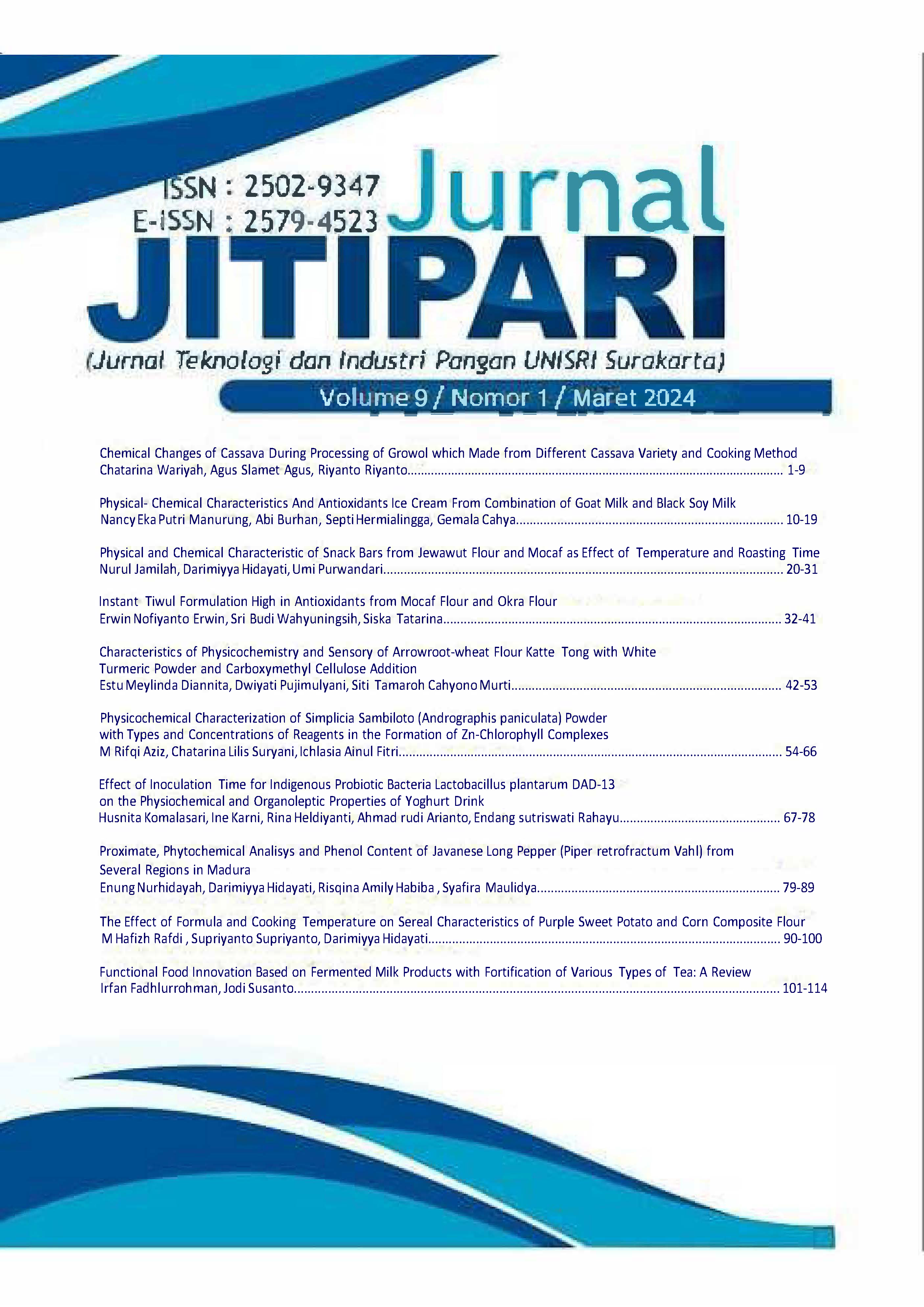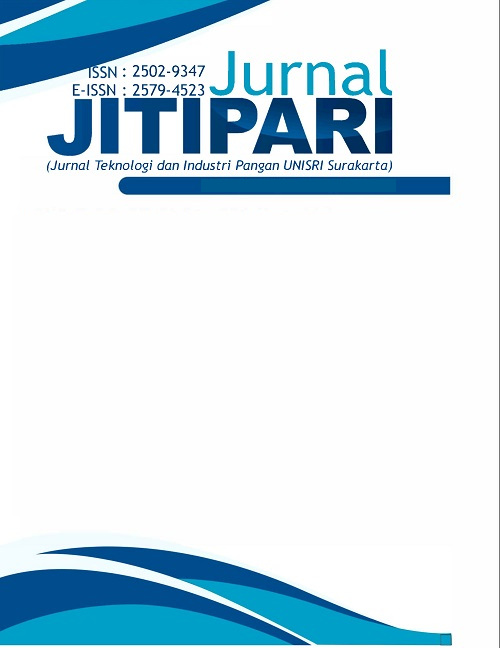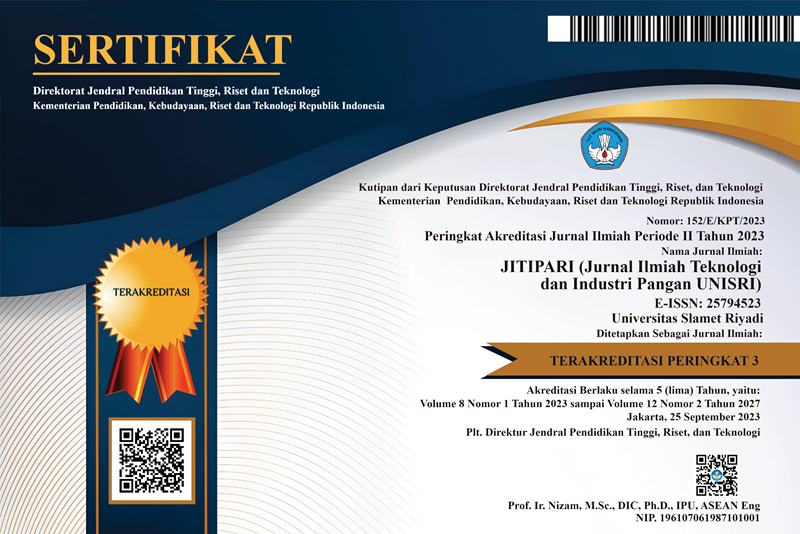Proximate, Phytochemical Analisys and Phenol Content of Javanese Long Pepper (Piper retrofractum Vahl) from Several Regions in Madura
Analisis Proksimat, Fitokimia dan Kadar Fenol Cabe Jamu (Piper retrofractum Vahl) dari Beberapa Daerah di Madura
DOI:
https://doi.org/10.33061/jitipari.v9i1.10225Abstract
Javanese long pepper (Piper retrofractum Vahl) is a native Indonesian spice that is found in many regions in Indonesia, especially in Madura. The cultivation of Javanese long pepper plants is spread across four large areas in Madura, that are Sumenep, Pamekasan, Sampang, and Bangkalan. Empirically, herbal chilies have been proven to be able to treat various diseases. This is closely related to the macronutrient content and bioactive compounds contained in herbal chilies. This research has carried out proximate analysis, phytochemical screening and phenolic content analysis of herbal chilies originating from four regions in Madura. The analysis results showed that Sumenep herbal medicine chili extract had the highest number of calories at 8,434 kcal. Meanwhile, Bangkalan herbal medicine chili extract has the lowest number of calories, namely 8,227 kcal. The results of this research also showed that Javanese long pepper contain six active compounds, five of which have been successfully tested with positive results (+) or have been proven to contain alkaloids, terpenoids, tannins, flavonoids, and carotenoids. Saponin compounds showed negative results (-) or there were no saponin compounds in Madurese herbal chilies. The total phenolic content of local Madurese herbal chilies from Pamekasan, Sampang, Sumenep and Bangkalan respectively, 44.63; 27.70; 25.49; and 22.70 mg GAE/g. The results showed that there were significant differences between the areas of the Javanese long pepper in terms of water content, protein content, fat content, carbohydrate content and phenol content (p<0.05).
References
AOAC, Association of Official Analytical Chemist. (2005). Official Methods of Analys.
A.J. Harborne. (1998). Phytochemical Methods A Guide to Modern Techniques of Plant Analysis.
Arianto, R., Nurbaeti, S. N., Nugraha, F., Fajriaty, I., Kurniawan, H., & Pramudio, A. (2022). Pengaruh Isolasi Cangkang Telur Ayam Ras Petelur terhadap Kadar Abu. Journal Syifa Sciences and Clinical Research, 4(2), 247–252. https://doi.org/10.37311/jsscr.v4i2.13982
Artini, P. E. U. D., Astuti, K. W., & Warditiani, N. K. (2013). Uji Fitokimia Ekstrak Etil Asetat Rimpang Bangle (Zingiber purpureum Roxb.). Jurnal Farmasi Udayana, 2(4), 1–7.
Astuti, M. D., Wulandari, M., Rosyidah, K., & Nurmasari, R. (2021). Analisis Proksimat dan Fitokimia Buah Pedada (Sonneratia ovata Back.). Jurnal Sains Dan Terapan Kimia, 15(2), 154–163. https://doi.org/10.20527/jstk.v15i2.10728
Auwal, M. S., Saka, S., Mairiga, I. A., Sanda, K. A., Shuaibu, A., & Ibrahim, A. (2014). Preliminary phytochemical and elemental analysis of aqueous and fractionated pod extracts of Acacia nilotica (Thorn mimosa). Veterinary Research Forum : An International Quarterly Journal, 5(2), 95–100.
Bahruddin, A., Zaka, U., Sholah, Mudarris, & Aziz, A. (2021). Pemanfaatan dan Prospek Budidaya Cabe Jamu di Dusun Nung Malaka Desa Daleman Kecamatan Galis Kabupaten Bangkalan. Jurnal Pengabdian Masyarakat, 1(2), 108–126.
Bandy, N. A., Erniwati, Muthmainnah, Ariyanti, Hapid, A., & Asniati. (2021). Analisis Fitokimia Ektrak Daun Bajakah (Poikilospermum suaveolens (Blume) Merr) dari Desa Kapiroe Kecamatan Palolo Kabupaten Sigi Provinsi Sulawesi Tengah. Jurnal Warta Rimba, 9(1), 31–41.
Bluto, K., & Subari, S. (2020). Analisis Usaha dan Nilai Tambah Koi Cabe Jamu di Kabupaten Sumenep (Studi Kasus CV. Alifa Jaya, Kecamatan Bluto). 1(3), 200–218.
Chaveerach, A., Mokkamul, P., Sudmoon, R., & Tanee, T. (2006). Ethnobotany of the Genus Piper (Piperaceae) in Thailand. Ethnobotany Research and Applications, 4, 223. https://doi.org/10.17348/era.4.0.223-231
Faizah, R. U., Hidayat, K., & Mu’tamar, M. F. F. (2022). Pengembangan Industri Cabe Jamu Madura. Wijayakusuma National Conference, 3(1), 83–87.
Fikriyah, Y. U., & Nasution, R. S. (2021). Analisis Kadar Air dan Kadar Abu pada Teh Hitam yang dijual di Pasaran dengan Menggunakan Metode Gravimetri. Jurnal Amina, 3(2), 50–54.
Gul, R., Jan, S. U., Faridullah, S., Sherani, S., & Jahan, N. (2017). Preliminary Phytochemical Screening, Quantitative Analysis of Alkaloids, and Antioxidant Activity of Crude Plant Extracts from Ephedra intermedia Indigenous to Balochistan. Scientific World Journal. https://doi.org/10.1155/2017/5873648
Halimu, R. B., Sulistijowati, R. S., & Mile, L. (2017). Identifikasi Kandungan Tanin pada Sonneratia alba. Jurnal Ilmiah Perikanan Dan Kelautan, 5(4), 93–97.
Hermita, N., Ningsih, E. P., & Fatmawaty, A. A. (2017). Analisis Proksimat dan Asam Oksalat pada Pelepah Daun Talas Beneng Liar di Kawasan Gunung Karang, Banten. Jurnal Agrosains Dan Teknologi, 2(2), 95–104.
Hidayat, R., Maimun, M., & Sukarno, S. (2020). Analisis Mutu Pindang Ikan Tongkol (Euthynnus affinis) dengan Teknik Pengolahan Oven Steam. Jurnal FishtecH, 9(1), 21–33. https://doi.org/10.36706/fishtech.v9i1.11003
Jadid, N., Arraniry, B. A., Hidayati, D., Purwani, K. I., Wikanta, W., Rosyda, S., & Rachman, R. Y. (2018). Proximate composition , nutritional values and phytochemical screening of Piper retrofractum vahl . fruits. 8(1), 37–43. https://doi.org/10.4103/2221-1691.221136
Jagessar, R. C. (2017). Phytochemical screening and chromatographic profile of the ethanolic and aqueous extract of Passiflora edulis and Vicia faba L. (Fabaceae) RC Jagessar. ~ 1714 ~ Journal of Pharmacognosy and Phytochemistry, 6(6), 1714–1721.
Lattanzio, V. (2014). Phenolic Compounds : Introduction. https://doi.org/10.1007/978-3-642-22144-6
Lestari, W. N., Wulandari, Y. W., Widanti, Y. A., & Nuraini, V. (2021). Perubahan Tingkat Kesukaan Konsumen Berdasarkan Parameter Sensoris Pada Produk Intip yang Disimpan dengan Perbedaan Suhu dan Lama Penyimpanan. Jurnal Ilmiah Teknologi Dan Industri Pangan UNISRI, 6(2), 64–74. https://doi.org/10.33061/jitipari.v6i2.5298
Lumowa, S. V. T., & Nurbayah. (2017). Kombinasi Ekstrak Cabe Jawa (Piper retrofractum Vahl.) dan Jahe Merah (Zingiber officinale var . amarum ) sebagai Insektisida Nabati pada Tanaman Sawi (Brassica juncea L.). Bioedukasi, 10(1), 65–70.
Makatambah, V., Fatimawali, F., & Rundengan, G. (2020). Analisis Senyawa Tannin Dan Aktifitas Antibakteri Fraksi Buah Sirih (Piper betle L) Terhadap Streptococcus mutans. Jurnal MIPA, 9(2), 75–80. https://doi.org/10.35799/jmuo.9.2.2020.28922
Mudjijono, Herawati, I., Munawaroh, S. & S. (2004). Kearifan Lokal Orang Madura Tentang Jamu untuk Kesehatan Ibu dan Anak. Yogyakarta: Balai Pelestarian Nilai Budaya.
Muhammad, A. F., Hartanto, R., Yudhistira, B., & Sanjaya, A. P. (2021). Analisis Mutu Fisik dan Kimia Caai awa (Piper retrofractum Vahl.) dengan Metode Pengeringan Oven Kabinet dan Pengeringan Sinar Matahari. Jurnal Teknologi Industri Pertanian, 15(4), 1001–1010. https://doi.org/10.21107/agrointek.v15i4.10407
Nasional, B. S. (1995). SNI 3709:1995 Rempah-rempah Bubuk.
Nasution, A. N., & Ulina, Y. Y. (2022). Uji Toksisitas Batang Tumbuhan Mahkota Dewa (Phaleria macrocarpa (Scheff.) Boerl.) Terhadap Larva Nyamuk Culex sp. Jambura Journal of Health Sciences and Research, 4(2), 587–595. https://doi.org/10.35971/jjhsr.v4i2.13943
Nurhaliza, Rudiyansyah, & Harlia. (2022). Perbandingan Metode Ekstraksi terhadap Kandungan Limonin pada Ekstrak Metanol Biji Jeruk Sambal (Citrus microcarpa Bunge). Indonesian Journal of Pure and Applied Chemistry, 5(1), 20–27.
Nurhidayah, R., Anwar, R., & Mayasari, L. O. (2019). Efektivitas Ekstrak Cabe Jawa (Piper retrofractum Vahl.) Terhadap Penurunan Leukosit Tikus Wistar yang Mengalami Ulkus Traumatikus. Jurnal Kedokteran Gigi, 13(2), 31–36.
Oshadie, G., Silva, D., Abeysundara, A. T., Minoli, M., & Aponso, W. (2017). Extraction methods, qualitative and quantitative techniques for screening of phytochemicals from plants. American Journal of Essential Oils and Natural Products, 5(2), 29–32.
Ramadhani, A., Saadah, S., & Sogandi, S. (2020). Efek Antibakteri Ekstrak Daun Cengkeh (Syzygium aromaticum) Terhadap Escherichia coli dan Staphylococcus aureus. Jurnal Bioteknologi & Biosains Indonesia, 7(2), 203–214. https://doi.org/10.29122/jbbi.v7i2.4146
Sastrawan, I. N., Sangi, M., & Kamu, V. (2013). Skrining Fitokimia dan Uji Aktivitas Antioksidan Ekstrak Biji Adas (Feoniculum vulgare) Menggunakan Metode DPPH. Jurnal Ilmiah Sains, 13(2), 110–115. https://doi.org/10.35799/jis.13.2.2013.3054
Simorangkir, M., Surbakti, R., Barus, T., & Simanjuntak, P. (2017). Analisis Fitokimia Metabolit Sekunder Ekstrak Daun dan Buah Solanum blumei Nees ex Blume lokal. Jurnal Pendidikan Kimia, 9(1), 244–248. https://doi.org/10.24114/jpkim.v9i1.6186
Singh, V., & Kumar, R. (2017). Study of Phytochemical Analysis and Antioxidant Activity of Allium sativum of Bundelkhand Region. International Journal of Life-Sciences Scientific Research, 3(6), 1451–1458. https://doi.org/10.21276/ijlssr.2017.3.6.4
Sofiati, T., Asyari, A., & Sidin, J. (2020). Uji Kadar Air, Abu dan Karbohidrat pada Sagu Ikan Cakalang di Kabupaten Pulau Morotai. Jurnal Laot Ilmu Kelautan, 2(1), 23–30. https://doi.org/10.35308/jlaot.v2i1.2359
Sulastri, B. A., Adiba, E. M., & Suaibah, L. (2022). Pengaruh Label Halal terhadap Pendapatan Agroindustri Obat Tradisional dan Tanaman Rempah di Madura. Jurnal Ekonomi Dan Bisnis, 3(2), 99–108.
Syafriana, V., Dewanti, N. P., & Yulyana, A. (2022). Analisis Fitokimia dan Aktivitas Antibakteri Infusa Daun Sempur (Dillenia suffruticosa (Griff.) Martelli) Terhadap Shigella dysentriae dan Staphylococcus aureus. Jurnal Farmasi Etam, 1, 92–107. https://doi.org/10.52841/jfe.v1i2
Tuapattinaya, M. P., Simal, R., & Warella, J. C. (2021). Analisis Kadar Air dan Kadar Abu Teh Berbahan Dasar Daun Lamun (Enhalus acoroides). Jurnal Biologi Pendidikan Dan Terapan, 8(1), 16–21.
Vinay, S., Vahl, P., Vahl, P. R., Renuka, K., Palak, V., Harisha, C. R., Prajapati, P. K., & Scholar, P. D. (2012). Pharmacognostical and Phytochemical Study of Piper Longum L . and. Journal of Pharmaceutical and Scientific Innovation, 1(1), 62–66.
Downloads
Published
How to Cite
Issue
Section
License
Copyright (c) 2024 Enung Nurhidayah, Darimiyya Hidayati, Risqina Amily Habiba , Syafira Maulidya

This work is licensed under a Creative Commons Attribution-ShareAlike 4.0 International License.
Authors who publish this journal agree to the following terms:
- Authors retain copyright and grant the journal right of first publication with the work simultaneously licensed under a Creative Commons Attribution-ShareAlike 4.0 International (CC BY-SA 4.0) that allows others to share the work with an acknowledgement of the work's authorship and initial publication in this journal.
- Authors can separately make additional contractual arrangements for non-exclusive distribution published by the journal (e.g., publish it in a book), with an acknowledgement of its initial publication in this journal.
- Authors are allowed and encouraged to send their work via online (e.g., in the institutional repositories or their website) after published by the journal.










